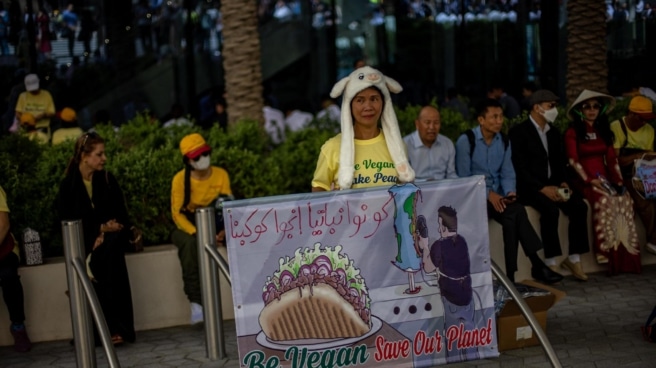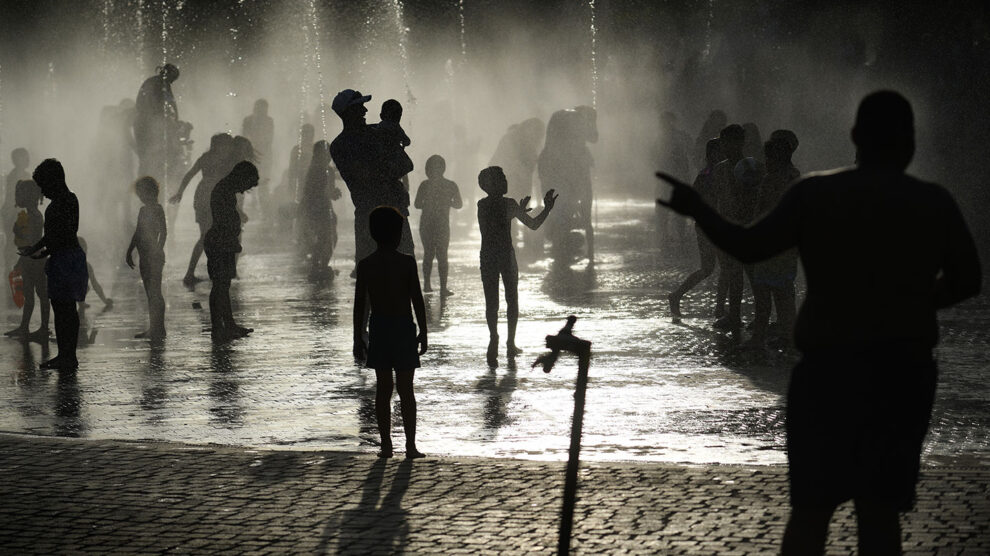

A man demonstrates outside Expo City Dubai, where COP28 is taking place.
For several days now, we have been talking at home about how “Mom is going to Dubai for a very important meeting on climate change.” My kids ask me how many days and nights I’ll be gone if I show them where “Dubai Country” is on a map, and my little son asks me, “What is a galactic shift.” Explaining to boys and girls what is happening, the future that awaits them if we don’t correct the course, is not easy, whether you are a mother or not. I tell them that people, we, have forgotten that we are part of nature and that planet Earth is our home, and that we have polluted our home so much that the Earth is sick and now it has a fever. My daughter, acting as big sister, adds with the clarifying wisdom of a 7-year-old girl, “Max, don’t we need to clean up our room after playing? Well, we still need to clean up and put the Earth in order.” to be able to continue playing.”
Let’s see how much we can “clean up” in this CS. Like previous COPs, this is an important COP, taking place at a difficult time – against the backdrop of the wars in Ukraine and Israel-Palestine – and with a decisive sense of urgency reduce CO2 emissions It is becoming more and more noticeable in the everyday life of all humanity. There is also an element of contradiction and lack of trust due to the host country. The United Arab Emirates is one of the world’s main oil producers and therefore has a significant role in the climate crisis. But even so, this COP is very important, and as a civil society we must remember that we do not decide where the next COP will be held, and that instead we have the power and responsibility to advocate for the proper functioning of the COP. system. United Nations Framework Convention on Climate Change (UNFCCC) ensure that the voices of all countries and all their civil societies are heard.
Why is COP28 important? let `s talk about global summing up o global assessment
193 countries that signed the agreement Paris Agreement They set three goals: 1) cut emissions enough to keep global temperature rise to “well below 2°C” above pre-industrial levels, and ideally 1.5°C; 2) increase the resilience of society to the consequences of climate change; and 3) align global financial flows with low-carbon and climate-resilient development.
They also agreed to evaluate their progress towards these goals every five years (starting in 2023) and to intensify their actions in response. This process is known as global assessment or Global summarizing in English. The first global assessment will be completed and presented at COP28.
This first balance or global assessment should, among other things, identify the gap between mitigation and adaptation and propose measures to correct it. If we focus solely on economics, mitigation currently accounts for 80% of climate finance. We must put people and their relationship with nature at the center of our attention. COP28 must recognize that biodiversity It is a vaccine for climate change, highlighting the importance of restoring and preserving nature and ensuring no one is left behind. At COP28, developed countries must provide the necessary funding to enable adaptation in countries that need it most, while helping them recover from inevitable losses and damage.
Adapt or die, the saying goes. And given the emergency we are experiencing, no one will take away the suffering caused by rising temperatures, increasing extremes or drought. So we have to adapt, trying to stop the cause of all this – greenhouse gases.
Let’s put cities at the center of the fight against climate change and adapt them for the future
Urban areas account for around 70% of global CO2 emissions, and many are particularly vulnerable to the impacts of climate change and require increasingly urgent adaptation plans. Science shows all cities must achieve net-zero emissions by 2050 to limit warming to 1.5°C. And while some have already made significant progress, they could go further by better aligning their actions with national governments through shared climate goals, investment and planning. However, UN climate summits have focused almost exclusively on climate action at the national level, and this has been a serious miscalculation.

Science shows that all cities must achieve net-zero emissions by 2050 to limit warming to 1.5°C.
Gray cities full of cement are very expensive in the long run, require a lot of maintenance and create a landscape that robs us of our well-being and health. Today, science is betting on greener cities that contribute to the fight against climate change through so-called nature-based solutions – actions based on preserving, restoring or enhancing biodiversity to protect us from climate change. Some examples of such actions:
- a) Plans green citieswhich are already creating friendlier, less hot, less polluted, less noisy and healthier cities.
- b) Creation climate shelters with plants and water within the city. Published scientific data shows that climate shelters in cities save thousands of people every year.
- c) dsustainable water management, investing in aquifer restoration and remediation, wetland protection, or riparian forest restoration. These actions have also increased the availability of water in Mediterranean regions such as ours.
- d) On the beaches restoration of natural duneswith plants typical of these ecosystems, or by leaving algae in the sand.
These actions have been shown to protect the beach better than seawalls, which retain sand from one location and remove it from another.
It is important that this summit finally recognizes this link between biodiversity and climate change, and all the science that supports it, as a central element, because we cannot understand adaptation without integrating nature into the equation.
Strengthen collaboration between national, regional and local governments to achieve their climate goals faster.
If we trust our nature as life insurance, it will have to be managed in a way that gets close to the territory. Here another important task arises for the current Constitutional Court – cooperation between national and subnational authorities – local and regional – in the implementation of decisions taken in the context of the Constitutional Court. Subnational governments do not have a say in these summits, but their voice is key because their administrations are most closely connected to the territories, they know local players and can act as innovation laboratories for creating sustainable landscapes.
This COP28 we will see some progress in this direction: the first Local Climate Action Summit, the Second Ministerial Meeting on Urbanization and Climate Change, the Delegation of Mayors to the World Climate Action Summit and the Ministerial Meeting of Transport and Energy Ministers.
We are all moving in the same direction and together we can undoubtedly achieve even more climate ambitions.
At these events, subnational governments will present concrete proposals, as well as assert their significant role at the forefront of the fight against climate change, add more funding and demand greater international connections. But these kinds of events cannot be unique cases, they need to be repeated and replicated in other international forums, because we are all moving in the same direction and together we can undoubtedly take on more climate ambitions.
For me, now is the time to propose the idea of small-scale work that, if it works, has the potential to multiply and catalyze the change needed to build a much more sustainable future.
Like every police officer, I leave with a mixture of emotions, among which I highlight hope. Because, like at every COP, no matter the challenges, geopolitics or the stagnation of some negotiations, I meet thousands of people from all over the world who, not only during the COP, but throughout the year, work tirelessly to ensure a bright future. green and blue, more sustainable, fairer and better for everyone.
I don’t know what will happen at COP28, and I don’t know what my children will ask me when I return, but I do know that I will be able to tell them and myself: that the world is full of people “cleaning and tidying up” planet Earth, and I will start playing with them while I tell them.
________________
Alicia Perez-Porro She is the scientific coordinator of the Center for Environmental Research and Forestry. (CREAF)
Source: El Independiente